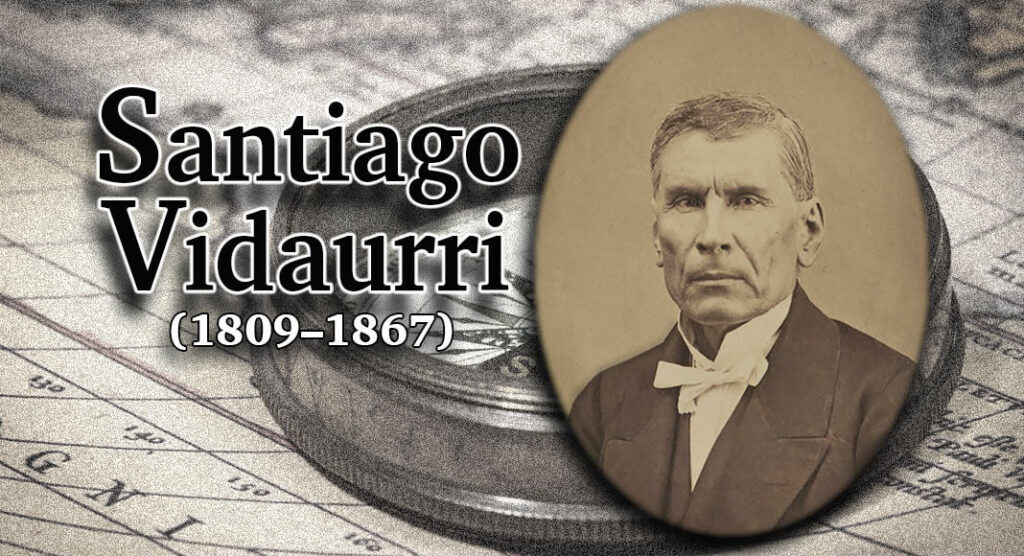
Texas Border Business
SANTIAGO VIDAURRI, (1809–1867). Santiago Vidaurri, a powerful caudillo in northeastern Mexico, son of Pedro Vidaurri and Teodora Valdés de Vidaurri, was born in Lampazos, Nuevo León, Mexico, on July 25, 1809. In his youth Vidaurri worked as a clerk for the police in Nuevo León. In 1837 he became the chief assistant to Governor Joaquín García, and in the 1840s he served as a secretary for Governor Manuel María de Llano.
The young bureaucrat traveled to Texas in 1841 to spy on Mirabeau B. Lamar‘s Texan Santa Fe Expedition. Throughout the 1840s and early 1850s he worked for conservatives in the Mexican government. After Mexico’s loss to the United States in 1848 (see MEXICAN WAR), Vidaurri and other young politicians became dissatisfied with conservative politics. Denouncing the regime of Antonio López de Santa Anna under a plan labeled “Restaurador de la Libertad,” Vidaurri captured Monterrey on May 23, 1855, and was installed as governor and military commander of Nuevo León. His army moved rapidly into the neighboring states of Coahuila and Tamaulipas, consolidating control throughout northeastern Mexico. To procure weapons and other military supplies, he turned to merchants north of the Rio Grande. When charged with an attempt to establish the “Republic of Sierra Madre,” Vidaurri insisted that his was a federalist movement in the best of liberal traditions. He cooperated with United States and Texas authorities in punishing Indians who raided the frontier, but clashed with Texan raiders of the Callahan expedition (who crossed into Coahuila in September 1855 to pursue hostile Indians and fugitive slaves), protesting the violations of Mexican territory.
Vidaurri annexed Coahuila on February 19, 1856, decreeing the formation of the combined state of Nuevo León y Coahuila. For the next two years he controlled this vast territory virtually as an independent nation. Many Liberals in the government of Benito Juárez distrusted the chieftain, but were forced to seek the assistance of his Army of the North in the vicious War of the Reform. In September 1858, however, the northern caudillo suffered a major defeat at the hands of the conservatives near San Luis Potosí, and retreated to Monterrey to rebuild his forces. He continued to give lip service to the national liberal government, but kept his army out of battle. Furthermore, he retained all revenues collected at the Rio Grande customshouses. National liberals, including Benito Juárez, denounced him; and some of the most able officers of Nuevo León defected to the national cause.
When Texas in 1861 seceded from the United States and joined the Southern Confederacy in the Civil War, a Yankee naval blockade soon closed off all Gulf ports, including those of Texas. Confederate agents established alternative trade routes through northern Mexico, thus allowing European goods to flow from Tampico and Matamoros into Texas, and a vast quantity of cotton to move in the other direction. Vidaurri controlled much of the region in which this lucrative trade developed. By 1862 his hold on the fiefdom seemed stronger than ever, as he extended cooperation and warm friendship to Jose Agustín Quintero, the able Confederate agent who resided in Monterrey. At the same time, the Texas Rangers under John S. (Rip) Ford helped to protect trade north of the river. When United States forces seized Brownsville in 1863, the commerce shifted upriver to Laredo and Eagle Pass.
Meanwhile, the army of Napoleon III invaded Mexico and installed Maximilian on the throne. In 1863 Benito Juárez once again fled from the capital, reaching Nuevo León the next February. Vidaurri at first refused to allow him to enter Monterrey. Fearing rebellion by his own people, however, the governor abandoned his fiefdom and took refuge in Texas. When Juárez moved to El Paso in August 1864, a French army occupied Monterrey, and Vidaurri returned. On September 7, 1864, the caudillo offered his services to Emperor Maximilian. He did not remain in Nuevo León, however, but moved to central Mexico, where he became an effective member of the imperial government. When the Empire collapsed in June 1867, the army of Porfirio Díaz occupied Mexico City. A squadron arrested Vidaurri and executed him without a trial as a traitor to the Mexican nation.
The caudillo’s wife, Juana María Vidaurri de Vidaurri, died in 1865. His son Indalecio Vidaurri served in the militia of Nuevo León and in the imperial army. Vidaurri’s daughter Pudenciana married a prominent Irish merchant, Patricio Milmo, who profited greatly from the border trade during the Civil War. The Milmo family continued to play a prominent role in the commercial growth of Monterrey during the latter half of the nineteenth century.
Biography by Edward H. Moseley, Handbook of Texas Online
Published by the Texas State Historical Association












